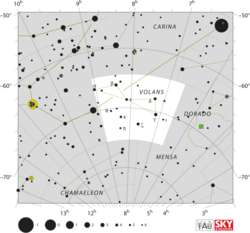Astronomy:Eta Volantis
| Observation data Equinox J2000.0]] (ICRS) | |
|---|---|
| Constellation | Volans |
| Right ascension | 08h 22m 04.45155s[1] |
| Declination | −73° 23′ 59.9258″[1] |
| Apparent magnitude (V) | 5.28±0.01 |
| Characteristics | |
| Spectral type | A0/1 IV/V[2] |
| B−V color index | +0.01[3] |
| Astrometry | |
| Radial velocity (Rv) | +20.0±3.7[4] km/s |
| Proper motion (μ) | RA: −29.432[1] mas/yr Dec.: +29.926[1] mas/yr |
| Parallax (π) | 8.4310 ± 0.0887[1] mas |
| Distance | 387 ± 4 ly (119 ± 1 pc) |
| Absolute magnitude (MV) | −0.06[5] |
| Details | |
| Mass | 2.73±0.08[6] M☉ |
| Radius | 3.78±0.12[7] R☉ |
| Luminosity | 84[8] L☉ |
| Surface gravity (log g) | 3.81±0.04[6] cgs |
| Temperature | 9,789±427[9] K |
| Rotational velocity (v sin i) | 214[10] km/s |
| Age | 347[6] Myr |
| Other designations | |
| Database references | |
| SIMBAD | data |
Eta Volantis, Latinized from η Volantis, is a single star[12] in the southern constellation of Volans. It has an apparent visual magnitude of 5.28,[13] which is bright enough to be seen with the naked eye as a dim, white-hued star. Based upon parallax measurements, it is approximately 387 light years from the Sun. The star is moving further away from the Sun with a radial velocity of 20 km/s.[4]
This is an A-type star with a stellar classification of A0/1 IV/V,[2] displaying blended spectrum that shows aspects of a main sequence star and a subgiant. Stellar evolution models from Zorec and Royer (2012) place it near the main sequence turnoff, having completed 90.7% of its time on the main sequence. The star is estimated to be 347 million years old[6] and is spinning rapidly with a projected rotational velocity of 214 km/s.[10] It has 2.73 times the mass of the Sun[6] and 3.43 times the Sun's radius.[7] Eta Volantis is radiating 84[8] times the luminosity of the Sun from its photosphere at an effective temperature of 9,789 K.[9]
Eta Volantis has two 12th magnitude optical companions at angular separations of 26.8 and 48.1 arcseconds.[14]
References
- ↑ 1.0 1.1 1.2 1.3 1.4 Vallenari, A. et al. (2022). "Gaia Data Release 3. Summary of the content and survey properties". Astronomy & Astrophysics. doi:10.1051/0004-6361/202243940 Gaia DR3 record for this source at VizieR.
- ↑ 2.0 2.1 Houk, N.; Cowley, A. P. (1975). University of Michigan Catalogue of two-dimensional spectral types for the HD stars. Volume I. Declinations −90° to −53°. Bibcode: 1975mcts.book.....H.
- ↑ Mermilliod, J.-C. (1986), "Compilation of Eggen's UBV data, transformed to UBV (unpublished)", Catalogue of Eggen's UBV Data. SIMBAD, Bibcode: 1986EgUBV........0M.
- ↑ 4.0 4.1 Kharchenko, N. V. et al. (2007), "Astrophysical supplements to the ASCC-2.5: Ia. Radial velocities of ˜55000 stars and mean radial velocities of 516 Galactic open clusters and associations", Astronomische Nachrichten 328 (9): 889, doi:10.1002/asna.200710776, Bibcode: 2007AN....328..889K.
- ↑ Anderson, E.; Francis, Ch. (May 2012). "XHIP: An extended hipparcos compilation". Astronomy Letters 38 (5): 331–346. doi:10.1134/S1063773712050015. ISSN 1063-7737. Bibcode: 2012AstL...38..331A.
- ↑ 6.0 6.1 6.2 6.3 6.4 Gerbaldi, M.; Faraggiana, R.; Burnage, R.; Delmas, F.; Gómez, A. E.; Grenier, S. (June 1999). "Search for reference A0 dwarf stars: Masses and luminosities revisited withHipparcos parallaxes". Astronomy and Astrophysics Supplement Series 137 (2): 273–292. doi:10.1051/aas:1999248. ISSN 0365-0138. Bibcode: 1999A&AS..137..273G.
- ↑ 7.0 7.1 Stassun, Keivan G. et al. (9 September 2019). "The Revised TESS Input Catalog and Candidate Target List". The Astronomical Journal 158 (4): 138. doi:10.3847/1538-3881/ab3467. Bibcode: 2019AJ....158..138S.
- ↑ 8.0 8.1 McDonald, I.; Zijlstra, A. A.; Boyer, M. L. (2012). "Fundamental Parameters and Infrared Excesses of Hipparcos Stars". Monthly Notices of the Royal Astronomical Society 427 (1): 343–57. doi:10.1111/j.1365-2966.2012.21873.x. Bibcode: 2012MNRAS.427..343M.
- ↑ 9.0 9.1 Paunzen, E.; Schnell, A.; Maitzen, H. M. (October 2006). "An empirical temperature calibration for the Δa photometric system II: The A-type and mid F-type stars". Astronomy & Astrophysics 458 (1): 293–296. doi:10.1051/0004-6361:20064889. ISSN 0004-6361. Bibcode: 2006A&A...458..293P.
- ↑ 10.0 10.1 Royer, F. et al. (February 2007), "Rotational velocities of A-type stars. III. Velocity distributions", Astronomy and Astrophysics 463 (2): 671–682, doi:10.1051/0004-6361:20065224, Bibcode: 2007A&A...463..671R.
- ↑ "* eps Vol". SIMBAD. Centre de données astronomiques de Strasbourg. http://simbad.u-strasbg.fr/simbad/sim-basic?Ident=%2A+eps+Vol.
- ↑ Eggleton, P. P.; Tokovinin, A. A. (September 2008), "A catalogue of multiplicity among bright stellar systems", Monthly Notices of the Royal Astronomical Society 389 (2): 869–879, doi:10.1111/j.1365-2966.2008.13596.x, Bibcode: 2008MNRAS.389..869E.
- ↑ Høg, E.; Fabricius, C.; Makarov, V. V.; Urban, S.; Corbin, T.; Wycoff, G.; Bastian, U.; Schwekendiek, P. et al. (March 2000). "The Tycho-2 catalogue of the 2.5 million brightest stars". Astronomy and Astrophysics 355: L27–L30. ISSN 0004-6361. Bibcode: 2000A&A...355L..27H.
- ↑ Mason, B. D. et al. (2014), "The Washington Visual Double Star Catalog", The Astronomical Journal 122 (6): 3466, doi:10.1086/323920, Bibcode: 2001AJ....122.3466M
 |

